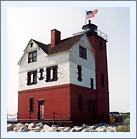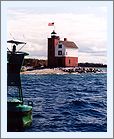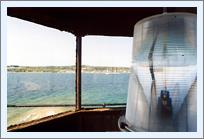|
Historical Information

The area around the Straits
of Mackinac is riddled with islands and reefs, which made vessel traffic
at the transition from Lakes Huron, Michigan and Superior particularly
difficult. While the construction of the Old Mackinac Point Light in
1892 eased the situation, the Lighthouse Board requested funds from
Congress to augment the Mackinac Light with a second light in the
Straits to be located on a shoal off Round Island.
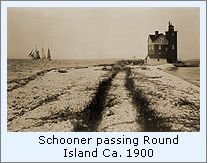 Congress responded to the request with
an appropriation of $15,000 for the construction of such a light in
1894. The construction contract was awarded to the local contractor
Frank Rounds. The construction was completed, and the light first
exhibited on May 15. Congress responded to the request with
an appropriation of $15,000 for the construction of such a light in
1894. The construction contract was awarded to the local contractor
Frank Rounds. The construction was completed, and the light first
exhibited on May 15.
Set on a forty-foot square concrete
pier, the three-story red brick building became home to the Head Keeper
and two assistants. The first floor held the boiler and compressors for
the steam-operated foghorn. Mounted on a shelf on the exterior of the
second floor, compressed air was piped up to the second floor via iron
pipes on the inside wall of the building.
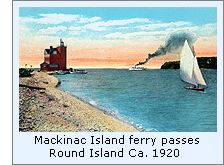 The second floor contained the keepers'
kitchen, living room, dining room and one small bedroom. The third floor
held three bedrooms, and a service room, which also provided access to
the tower and lantern room by way of an iron ladder. The second floor contained the keepers'
kitchen, living room, dining room and one small bedroom. The third floor
held three bedrooms, and a service room, which also provided access to
the tower and lantern room by way of an iron ladder.
Equipped with a Fourth Order Fresnel
lens, the lamp showed steady white with a flash of red every twenty
seconds. The lamp was rotated with a clockwork occulting mechanism,
which was powered by weights hanging in a weight pocket built into the
wall. This pocket extended down through all three floors and each floor
provided with a weight access door.
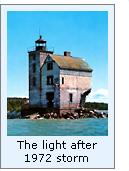 Automated in 1924, the keepers and
their belongings were removed from the station. After the Coast Guard
assumed responsibility for the Nation's lighthouses in 1939, the
automated Round Island Passage Light was erected off the harbor
breakwater on Mackinac Island in 1947. Thus, Round Island Light was
deemed to be no longer necessary as a navigational aid, and was
abandoned and left to
the elements. Round Island became part of the Hiawatha National Forest
in 1958, and as part of the transfer, the lighthouse became Park
property also. Over the next twenty years the Park Service gutted the
interior, and without the ongoing care afforded by the keepers of the
past, the exterior of the building began to deteriorate. Automated in 1924, the keepers and
their belongings were removed from the station. After the Coast Guard
assumed responsibility for the Nation's lighthouses in 1939, the
automated Round Island Passage Light was erected off the harbor
breakwater on Mackinac Island in 1947. Thus, Round Island Light was
deemed to be no longer necessary as a navigational aid, and was
abandoned and left to
the elements. Round Island became part of the Hiawatha National Forest
in 1958, and as part of the transfer, the lighthouse became Park
property also. Over the next twenty years the Park Service gutted the
interior, and without the ongoing care afforded by the keepers of the
past, the exterior of the building began to deteriorate.
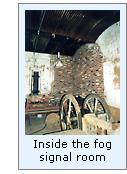 A particularly violent storm on October
20, 1972 blew so hard against the building that one lower corner of the
building was completely broken away. The resultant opening allowed
access to vandals, who could not resist working their destruction on the
once mighty building. A particularly violent storm on October
20, 1972 blew so hard against the building that one lower corner of the
building was completely broken away. The resultant opening allowed
access to vandals, who could not resist working their destruction on the
once mighty building.
Many Mackinac islanders feared the
entire structure would collapse, and were embarrassed by the poor
impression that the deteriorating building showed to the many visitors
coming into the island harbor. A groundswell of public desire to save
the lighthouse began to surface.
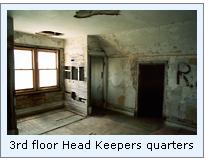 The Mackinac Island Society began to
investigate every avenue for funds and assistance. In late 1973 loads of
rip rap were spread around the base of the building to help stem
erosion. In 1974, the lighthouse was placed on the National Register of
Historic Places, and local groups friendly to the restoration effort
raised $12,000 through various drives and sales. However, restoration
experts estimated that that the cost to put the building back into
stable condition would be closer to $100,000, and while the Federal
Government showed willingness to lend assistance, the price tag was too
high. Finally, the Advisory Council on Historic Preservation stepped-in,
and appropriated $125,000 in 1977 for the restoration. The Mackinac Island Society began to
investigate every avenue for funds and assistance. In late 1973 loads of
rip rap were spread around the base of the building to help stem
erosion. In 1974, the lighthouse was placed on the National Register of
Historic Places, and local groups friendly to the restoration effort
raised $12,000 through various drives and sales. However, restoration
experts estimated that that the cost to put the building back into
stable condition would be closer to $100,000, and while the Federal
Government showed willingness to lend assistance, the price tag was too
high. Finally, the Advisory Council on Historic Preservation stepped-in,
and appropriated $125,000 in 1977 for the restoration.
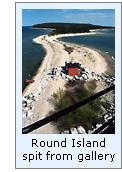 Naturally, in such a restoration
effort, there is a tremendous amount of labor involved, and Boy Scout
Troup 323 and The Great Lakes Lighthouse Keepers Association stepped-up
to answer the call. With the GLLKA providing the knowledge, and the
Boy Scouts providing the muscle, the work progressed rapidly. Naturally, in such a restoration
effort, there is a tremendous amount of labor involved, and Boy Scout
Troup 323 and The Great Lakes Lighthouse Keepers Association stepped-up
to answer the call. With the GLLKA providing the knowledge, and the
Boy Scouts providing the muscle, the work progressed rapidly.
Today, the exterior of the Round Island
Light appears as good as must have during its active days. Still serving
as an active aid to navigation, a 300mm
Acrylic lantern now guides mariners passing through the Straits.
Plans are
ongoing for interior restoration and further exterior improvements, and
once again Round Island stands proud at the entrance to Mackinac Island
Harbor.

Keepers of
this Light

Click here
to see a complete listing of all Round Island Light keepers compiled by
Phyllis L. Tag of Great Lakes Lighthouse Research.

Finding
this Light

Sheplers Ferry Service out of Mackinaw City offers a number of lighthouse cruises during the summer season. Their "Eastbound Tour" includes passes by Round Island, Bois Blanc Island, Poe Reef and Fourteen Foot Shoal. For schedules and rates for this tour, visit their website at:
www.sheplerswww.com or contact them at:
PO Box 250
Mackinaw City, MI 49701
Phone (800) 828-6157

Reference Sources

 Inventory of Historic
Light Stations, National Parks Service, 1994 Inventory of Historic
Light Stations, National Parks Service, 1994
Lighthouse Adventures, Wes Oleszewski, 1999
Lights Of The Lakes, Chris Duncan, Mich. Coastal Mgmt Program,
June 7 1984
Round Island Lighthouse, Lynne Cohen Duncan, Website.
Mackinac Town Crier News
USCG Historian's Office -
photographic archives.
Personal observation at Round Island, 09/10/1998
Photographs from the author's personal collection.
Keeper listings for this light appear
courtesy of Great
Lakes Lighthouse Research
|
